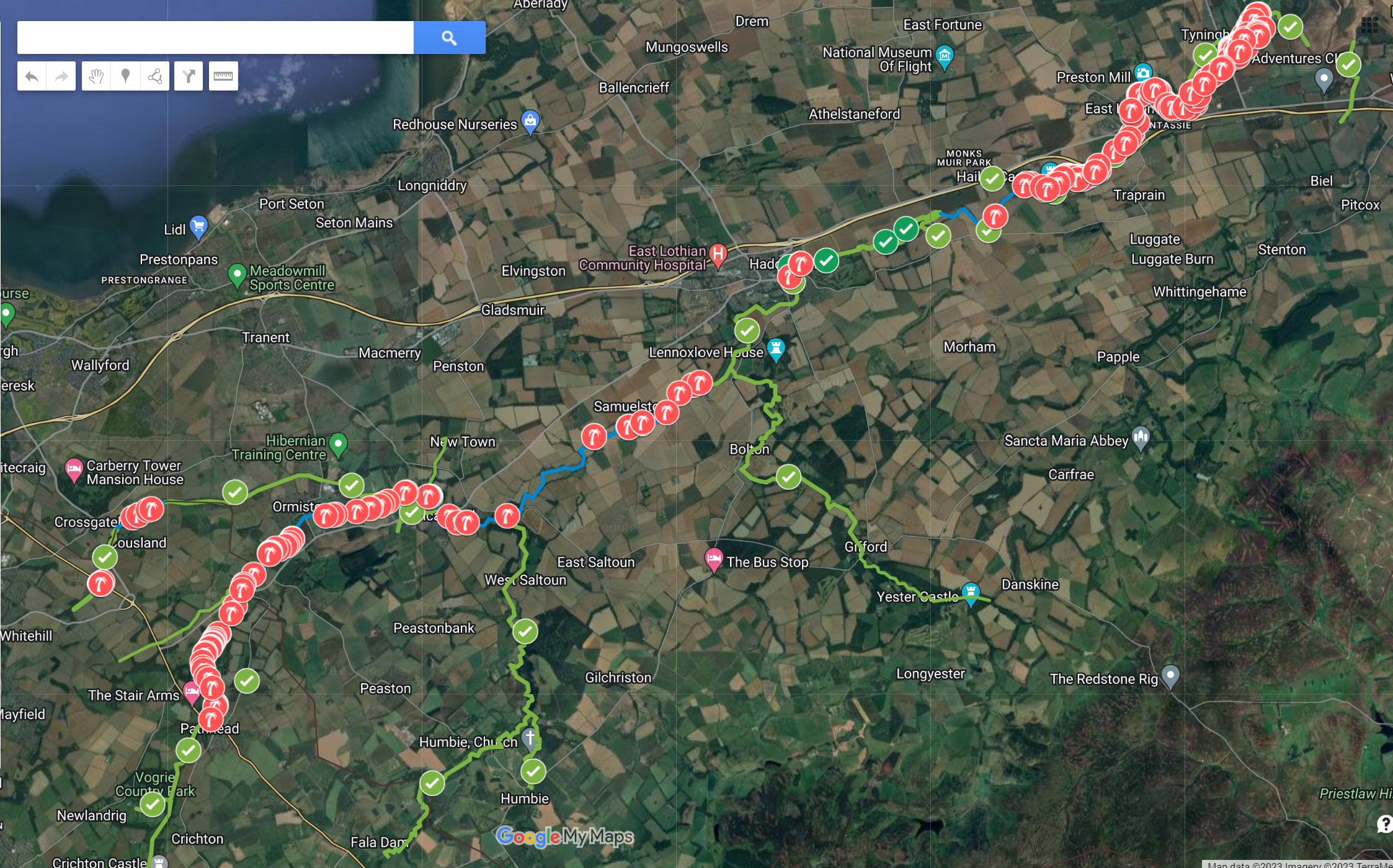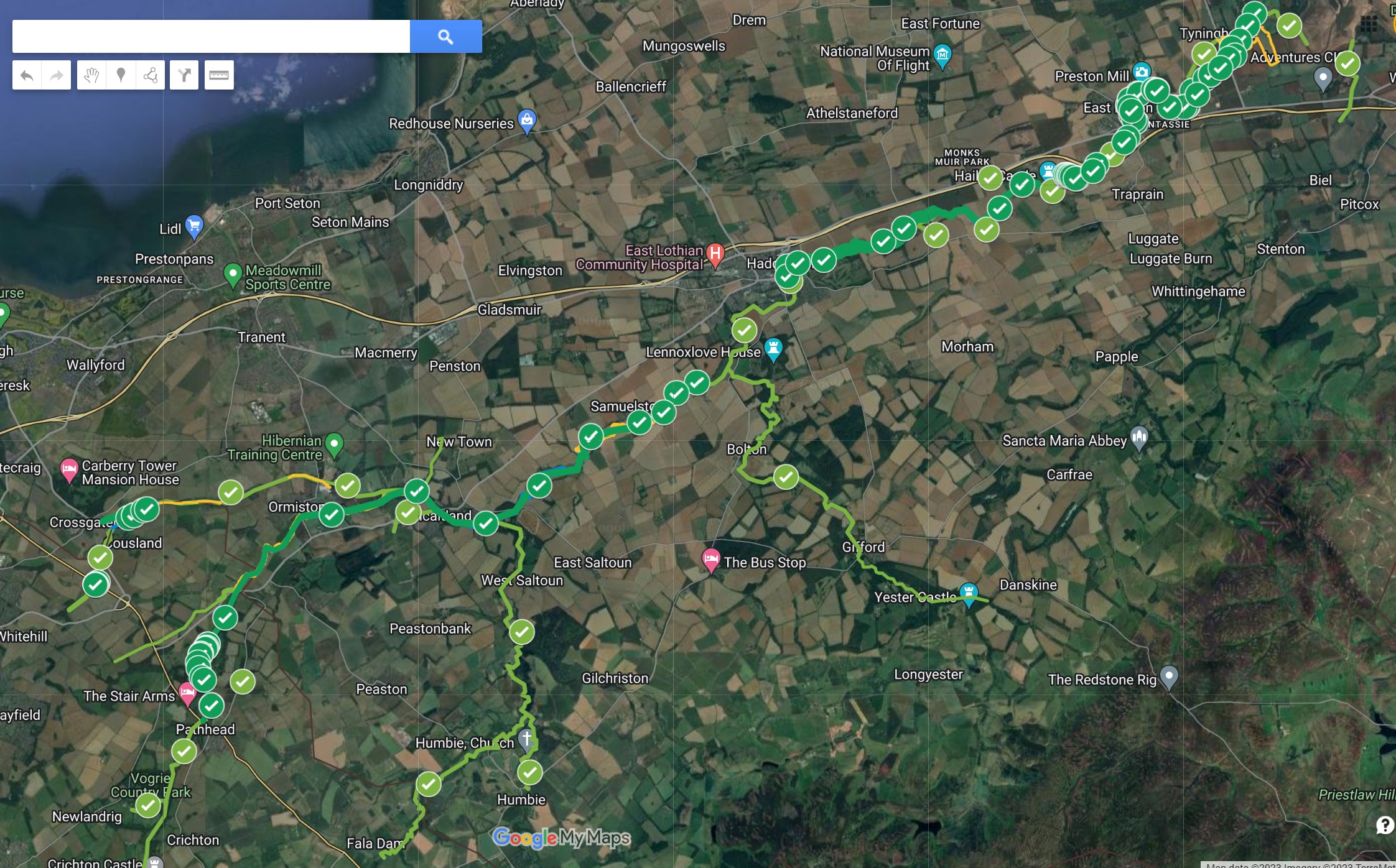2024 End of Season Report
Rivers Tyne & Esk Again Clear of Flowering Plants!

Once again (almost) no seeds were added to the riverside seedbank this year.
On the Tyne we reckon every visible plant was dealt with, and only a handful of flowering plants appeared, which were all properly dealt with. Click to see James’s full Tyne report here
The infestation on the Esk is a hundred times worse, but by the end of July there were only a few small pockets of flowering plants left untouched, everything else has been treated. See James’s full Esk report here
All due to the painstaking work of the many landowners and the spotters.
Special mention goes to Julia J for organising the Esk spotters, and for miles of surveys. Only surpassed by Ian B, who has now walked many of the Esk tributaries in Midlothian. But especially to James Wyllie, who continues to perform every role
Thank You All!
Click on any picture below to see more
Great Progress – River Tyne
- For the 6th year in a row we can say the River Tyne is free of any plant that could flower – and virtually every other plant too. Congratulations!
- This year on the 5km stretch between Pencaitland and Hailes -which has been clear of any flowering plants for years, we found half a dozen individual plants scattered along the river, one of which was even flowering. It just goes to show that we have to stay vigilant and thorough – seeds can lie dormant for years waiting for the right conditions to germinate. And thorough: a flowering one means we missed it last year, either we never found it, or we didnt treat it properly. – if we miss one
- On the Bellyford Burn, where three years ago there were a hundred flowering plants, there only a few small plants. Unfortunately the seeds had spread downstream onto a neighbouring properties, where despite everone’s efforts, there were still a dozen flowering, which needed to be laboriously mopped up.


Great Progress – River Esk
- With tens of thousands of plants it is a daunting task. But after 4 years of effort, nearly all areas are now being actively treated by their landowners, including Musselburgh golf course, Buccleuch Estates, and Sainsbury’s at Straiton. On our green-tick surveys, we found flowering plants in only a few areas.
- In Musselburgh it has spread well away from the river, infesting the Eskbank industrial estate, Inveresk cemetery, Tescos, even the Health Centre! And any area waste ground – we newly found it in the grounds of Edenhall hospital, which closed over 10 years ago. We quickly organised a mop-up session
- This year Ian surveyed many of the upstream tributaries in Midlothian – over 45km of them! Most had never been checked before, so we were delighted to find only 5 new pockets of Hogweed (although saddened to find any!). Fortunately we have found them early, so they havent yet had a chance to spread downstream. These were upstream of Lasswade stretching up to Polton, at Gorebridge on the railway, Bonnyrigg in a new housing estate, and Hardengreen Water Works, on the May Burn at Straiton. We identified most of the landowners, who are all now on board with the programme.
- The map below shows everything that was found during the year, and again after the green-tick survey. Move the slider to see before/after


Spotter News
- Spotters again surveyed all of the watercourses and recorded the GPS locations of any plants. Added to the Google maps makes it quicker for the landowners to know where to spray, easier for our “green tick” surveys (where late season we double check that all plants have gone), and enables accurate progress monitoring.
- Ian has this year surveyed many more of the Esk tributaries in Midlothian. The good news is we now know for sure that many more miles are clear of hogweed. The bad news is he found 5 new isolated infested areas. But good news: we have now dealt with all of them!
- Training: In the spring three new spotters have joined our team, were trained, and have surveyed their allocated non-river regions in East Lothian. Thanks to Debs-J, Martin-L and David-G. Two existing spotters also joined in the training as a refresher. Major thanks to Julia, both for organising the spotters, and doing a lot of spotting!
- Next year we hope next year to complete our coverage of every mile of waterway. Because you can never be sure – a car crossing a bridge, or a bird perched on an overhead cable, can once in a blue moon drop a seed which reaches triver, and then another unrelated infestation begins.



River Tyne
- 93 km of river & tributaries
- 26 km Significant GH
- 10 km Isolated Plants
- 44 km Very Unlikely
- 13 km Completely Clear!
- Plants
- 195 locations
- 490 plants
Statistics
This is our 6th year on the Tyne and its tributaries, the 4th on the Esk in Musselburgh, and the 3rd covering the whole Esk catchment. We now cover the Tyne from Tyninghame up to Pathhead, the Bellyford Burn from Pencaitland up to the A68, the Esk in Musselbugh up through Inveresk, Dalkeith Country Park, the North Esk up to Penicuik, the South Esk up to Gorebridge, the Dean/Park Burn up to its source in Straiton, and many smaller tributaries.
River Esk
- 125 km of river & tributaries
- 29 km Significant GH
- 52 km tbd, but unlikely
- 43 km Completely Clear (22k new!)
- Plants
- 1,500 locations, each with…
- x1 small upto x100 flowering
- 20,000? plants
- 1,500 locations, each with…
Hogweed Elsewhere
There are some flowering infestations not on our rivers. So whilst not so critical, wherever we hear of it we do our best to contact the landowners, who are always sympathetic, if not necessarily very active (the railways in particular)
This year we have allocated several new spotters to different off-river regions. They have reported only little evidence of treatment, unfortunately.

Some areas are really quite serious, for example:
- B&Q (very bad)
- Millerhill (very bad)
- Old Craighall
- Railway Embankments (very bad)
- Seton Sands
- Smeaton Electricity Substation
- Straiton/Sainsbury’s
Click the map to open the interactive version (or elcv.org.uk/HogweedMapLothian) to see the current status











